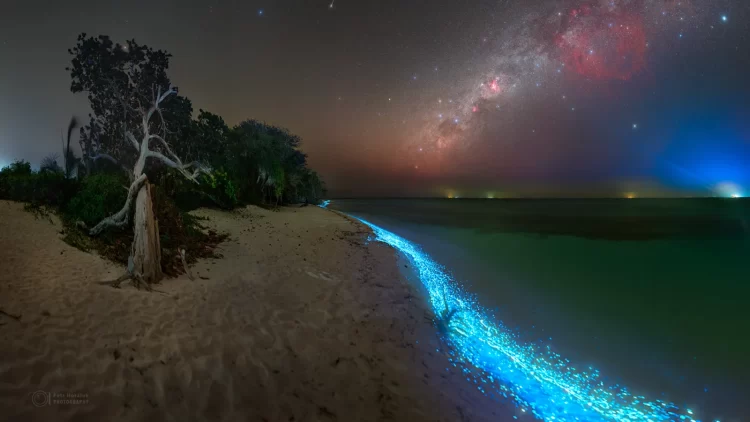A glittering expanse of the Indian Ocean glowed blue in the dark as if the stars were submerged underwater after falling from the sky. Along the shoreline, more tiny star-like dots were swept up by waves and tumbled onto the beach, lighting up the wet sand like a reflection of the night sky. They disappeared into the shadows in mere moments. I bounded across the beach and turned round to see my footprints rekindling the lights, leaving a glowing trail behind me. Dipping my toe into the twinkling blue water, the brightness intensified, like a swirling galaxy.
This incredible sight, commonly known as the “Sea of Stars”, is one of the highest-rated attractions in the Maldives. Stunning images of it proliferate online, inspiring adventurous travellers to seek it out. But few people can agree on exactly where you can find the Maldives’ Sea of Stars.
That’s because the Sea of Stars does not actually exist.
To clarify, the Maldives’ mysterious Sea of Stars does not exist as a geographical location. The simple reason for this is that these magical-looking lights are bioluminescent plankton that bob around the ocean.
“When people say they want to see the Sea of Stars in the Maldives, they are actually asking to see a chemical reaction – it’s bioluminescent plankton,” said marine biologist and wildlife presenter Lauren Arthur, who worked in the Maldives for eight years and recently returned to film sea life.
She explained that bioluminescence is a chemical reaction whereby light is produced, while plankton is a collective term for microscopic organisms that can’t control their movements – they just float around in currents. Not all plankton is capable of emitting light (only specific species can), but even then, they don’t emit light all the time, only when they are disturbed, she added. “There’s no one specific place to find bioluminescent plankton. It can be found anywhere in the Maldives, or even anywhere around the world where you get plankton, even the United Kingdom.
The Sea of Stars is one of the highest-rated attractions in the Maldives (Credit: Petr Horalek)
The Sea of Stars is one of the highest-rated attractions in the Maldives (Credit: Petr Horalek)
This means that while the Maldives’ famous Sea of Stars does not exist, you could still see something resembling a sea of stars – although witnessing it will largely come down to luck.
Arthur confirmed my good fortune in previously encountering lots of bioluminescent plankton on several islands around the Maldives, including Olhahali, Kurumba and Hulhumale in North Male’ Atoll. However, I lived in that atoll for five years and frequently return for lengthy visits, unlike most travellers who come to the Maldives for an average just of eight days, which makes seeing this elusive phenomenon harder.
I asked Arthur if a traveller visiting the Maldives on a time crunch can do anything to increase their chances of seeing a sea of stars in the Maldives. She recommended visiting during the Southwest Monsoon (which begins in April and runs until October) when the currents drive plankton from the south-west towards the north-east of the country and the largest amounts of plankton are found.
Arthur also believes you have a higher chance of seeing it underwater than on land.
“You may see it if you’re lucky while you’re sitting on the beach with a nice glass of Champagne, but luck is the key word,” said Arthur. “The best way to see it is to get into the water when it’s thick with plankton and go night snorkelling. It’s one of the most exciting things you can do.”
The best way to see it is to get into the water when it’s thick with plankton and go night snorkelling. It’s one of the most exciting things you can do
Arthur has also observed bioluminescent plankton many times during the new Moon, when there is very little ambient light, and she recommends travellers take the following steps:
“First, gather your group together in the water then turn off your waterproof torches. The minute you turn them off, it’s very eerie, but just start moving your arms and legs like crazy.” This will create movement in the water column. “You’re disturbing the plankton that will emit light – whether that’s being disturbed by a predator or even a human swimming. As soon as you disturb them, you’re floating amongst the stars.”
A few diving and water-sports centres, such as Maafushi Dive & Watersports, can provide night snorkelling trips, on request, to help you search for bioluminescent plankton.
Night snorkelling trips are an excellent way to see the bioluminescent plankton up close (Credit: Petr Horalek)
Night snorkelling trips are an excellent way to see the bioluminescent plankton up close (Credit: Petr Horalek)
While all the marine biologists I spoke to agreed with Arthur, none could offer a biological explanation for why two Maldivian islands with similar sounding names have become famous as the place to see the “Sea of Stars”. “It’s impossible for plankton to be attracted to any single island,” said Arthur.
Yet if you’re one of the 320,000 people a month worldwide searching on Google for “Sea of Stars”, you’ve probably found countless sources urging you to go to Vaadhoo or Vadoo. Vaadhoo is an inhabited island in Raa Atoll with a population of 626, while Adaaran Prestige Vadoo is a private resort island, some 120 miles away in South Male’ Atoll.
Bostan…

